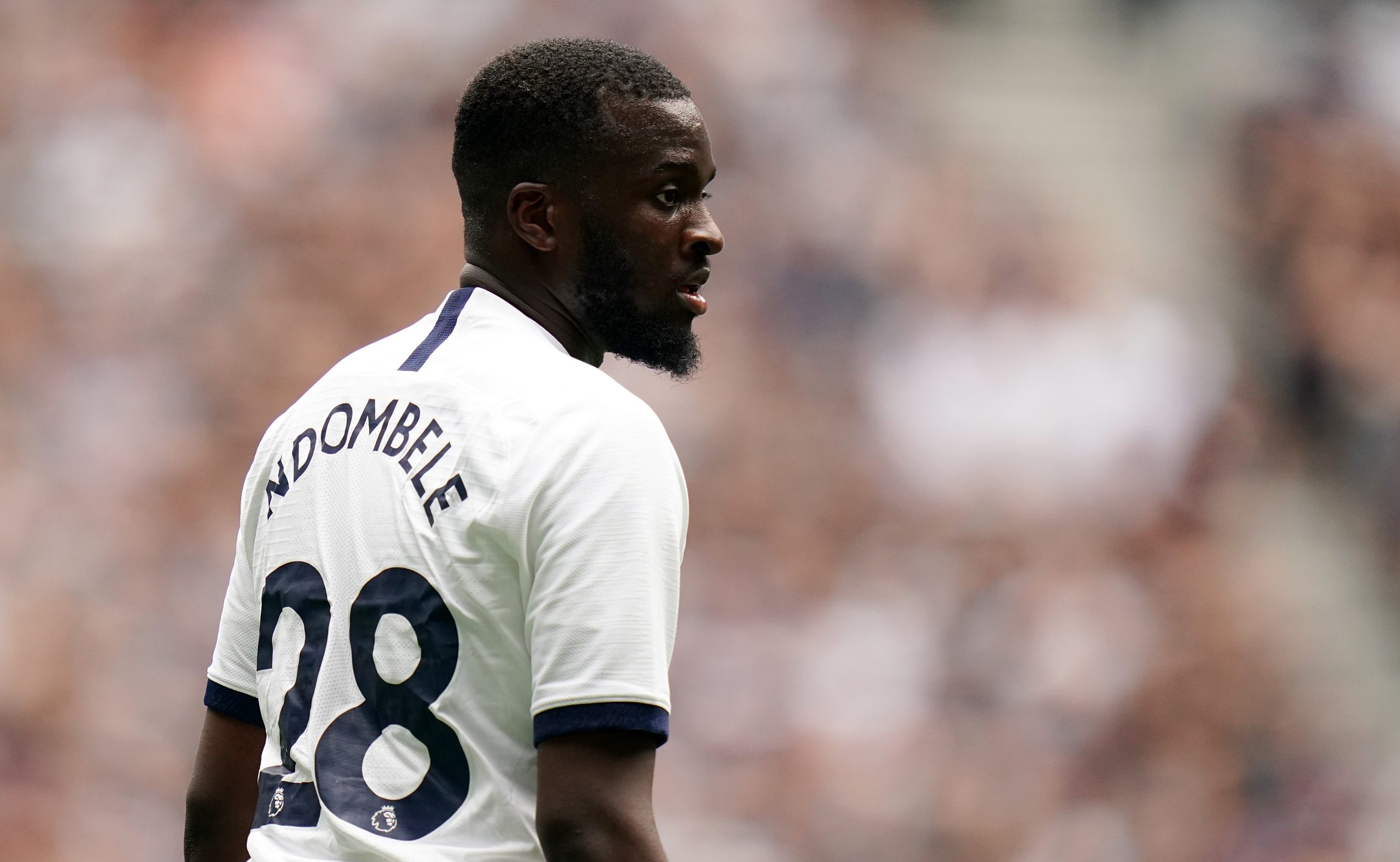What even are Tottenham Hotspur? Ten year ago Spurs were the team Colin Farrell compared to Purgatory in In Bruges. Now Spurs are Champions League mainstays, posting higher revenues than North London rivals Arsenal, and playing in a top class stadium after two years at Wembley. By all objective measures (save trophies), Spurs are one of the ten biggest clubs in world football. And yet, coming into Summer 2019, it was fair for Tottenham fans to wonder if the linear progression from midtable afterthoughts to Champions League finalists was over, and that the Champions League run was the beginning of the end of the Pochettino era club that had been defined by overwhelming teams in midfield. Despite the Pochettino Air Raid wizardry that led Spurs to the Final, the team was trending poorly: 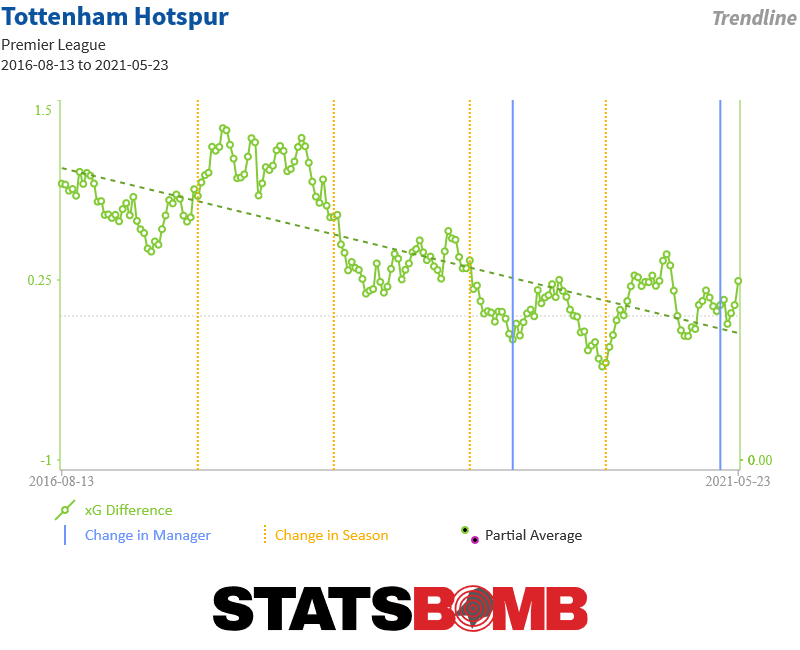 Mousa Dembele got old and left, Eric Dier hurt and bad, and with that, the stability and solidity in midfield that had defined Tottenham from 2015 to 2018 was gone. Spurs defensive actions and pressing rates went down.
Mousa Dembele got old and left, Eric Dier hurt and bad, and with that, the stability and solidity in midfield that had defined Tottenham from 2015 to 2018 was gone. Spurs defensive actions and pressing rates went down. 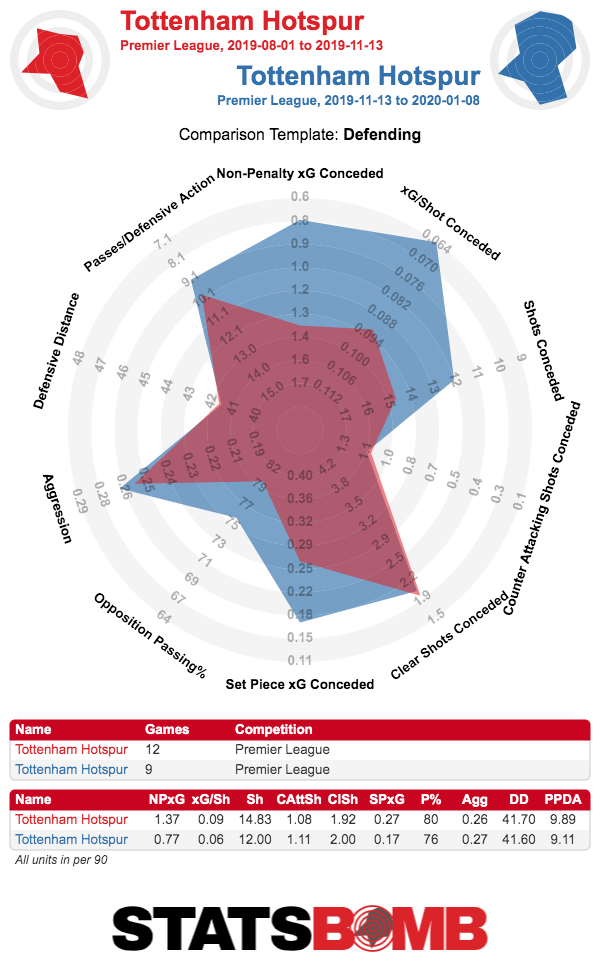 Turnovers went up as players couldn’t rely on Dembele to bail them out under pressure. The youth Spurs had been able to rely on to improve was gone: Kane, Son, and Eriksen, were no longer up and coming but at peak ages.
Turnovers went up as players couldn’t rely on Dembele to bail them out under pressure. The youth Spurs had been able to rely on to improve was gone: Kane, Son, and Eriksen, were no longer up and coming but at peak ages. 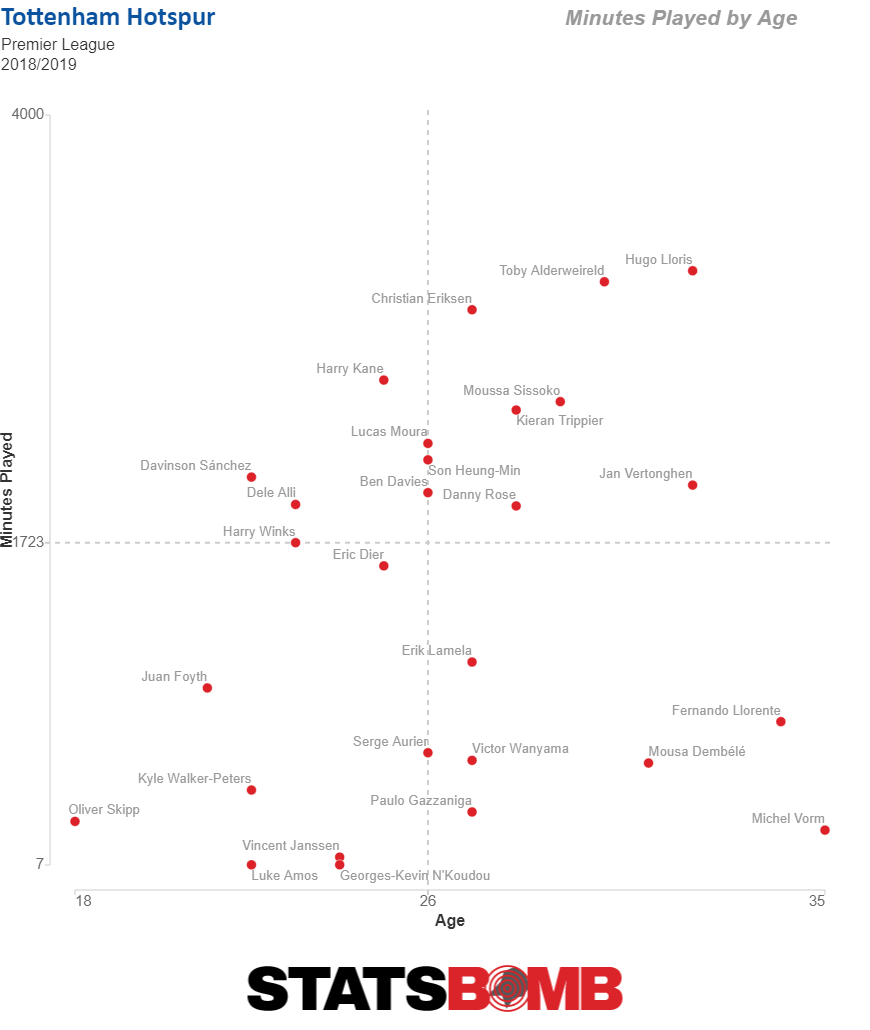 The peak level talent still performed, although Harry Kane fell off with a rash of ankle injuries. Dele Alli and Heung Min son, in particular, maintained elite form while filling in at slightly different roles. Toby Alderweireld and Jan Vertonghen remained one of the best defensive pairings in the world. Danny Rose got back some of that old time feeling after missing most of the 2017-2018 season and struggling when he played:
The peak level talent still performed, although Harry Kane fell off with a rash of ankle injuries. Dele Alli and Heung Min son, in particular, maintained elite form while filling in at slightly different roles. Toby Alderweireld and Jan Vertonghen remained one of the best defensive pairings in the world. Danny Rose got back some of that old time feeling after missing most of the 2017-2018 season and struggling when he played: 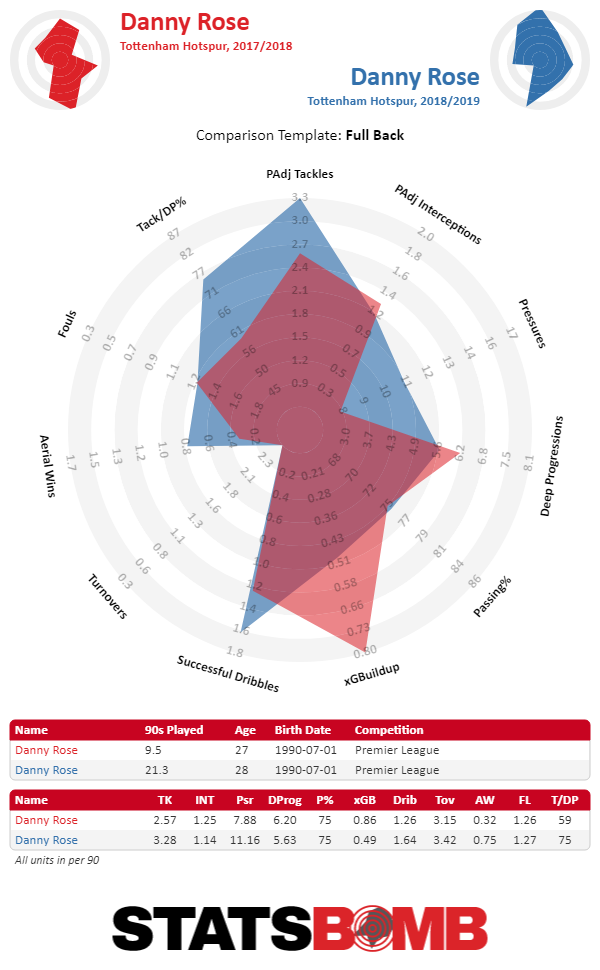 Still, after years of buying low, selling high, and buying new young players, Daniel Levy’s magic had seemingly worn out, or, at the very least, taken a stadium building vacation. His inability to delegate meant that the small staff at Tottenham was falling behind teams like Liverpool, with big analytics departments. Tottenham had not bought players in over 500 days, and some of their most recent purchases had included Vincent Janssen and Moussa Sissoko. Without a midfield, no fewer than four Tottenham players have had groin surgery since March, suffering muscle injuries from overwork. The team could not close out matches, dying at the 70th minute after playing constantly and with nobody useful to sub on:
Still, after years of buying low, selling high, and buying new young players, Daniel Levy’s magic had seemingly worn out, or, at the very least, taken a stadium building vacation. His inability to delegate meant that the small staff at Tottenham was falling behind teams like Liverpool, with big analytics departments. Tottenham had not bought players in over 500 days, and some of their most recent purchases had included Vincent Janssen and Moussa Sissoko. Without a midfield, no fewer than four Tottenham players have had groin surgery since March, suffering muscle injuries from overwork. The team could not close out matches, dying at the 70th minute after playing constantly and with nobody useful to sub on: 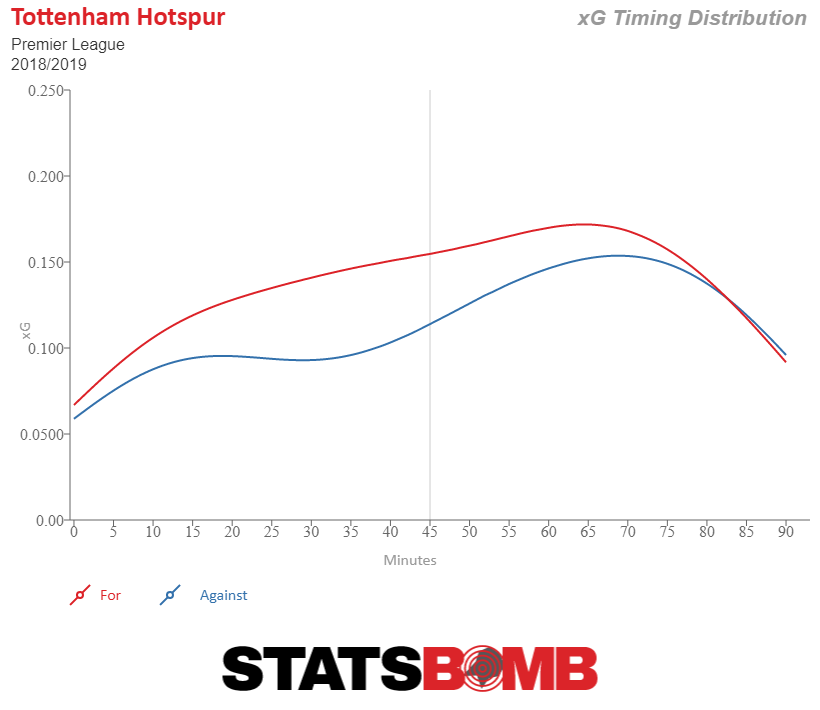 The fearsome Pochettino press of past seasons, which had been so imperious:
The fearsome Pochettino press of past seasons, which had been so imperious: 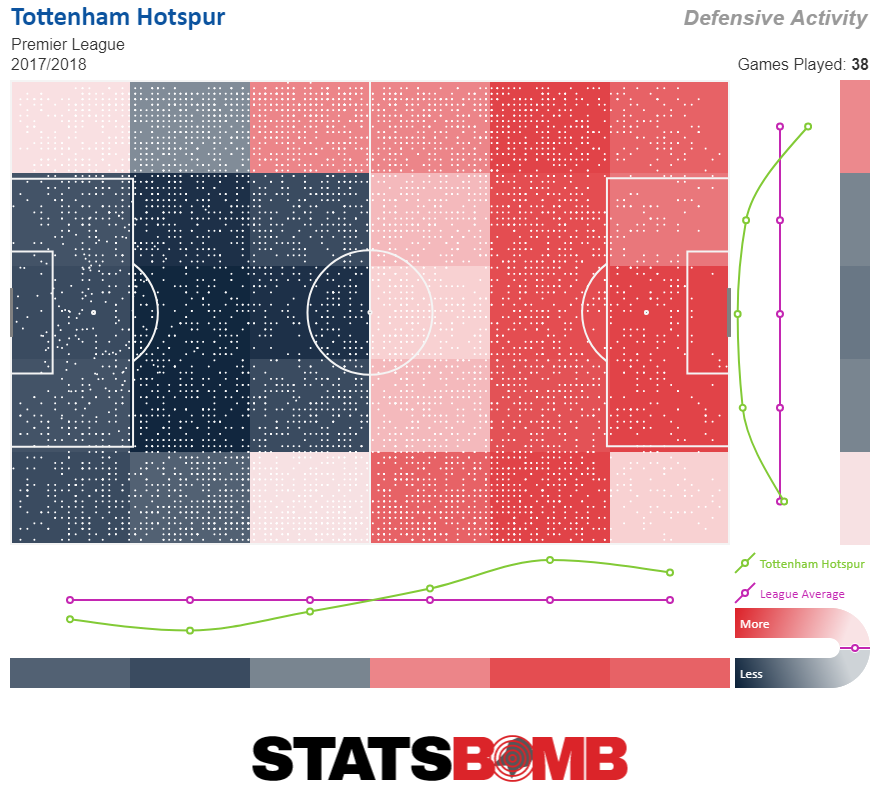 now couldn’t sustain itself:
now couldn’t sustain itself: 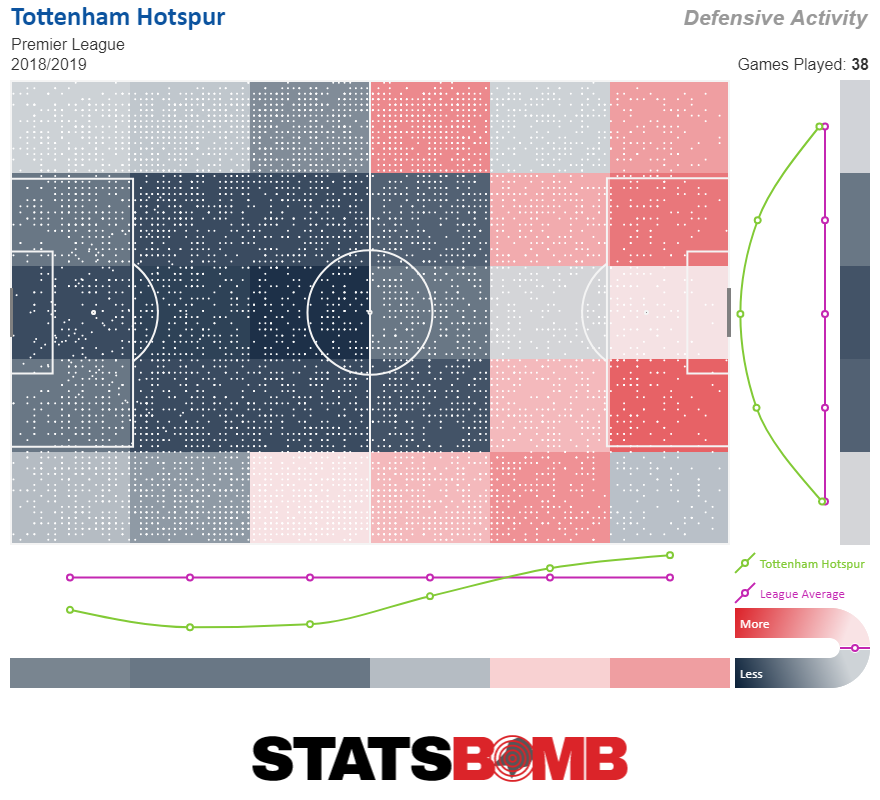 All season, including at the mid-winter break, Spurs fans demanded: Daniel Levy, buy a midfield please. No reinforcements came despite rumors about Youri Tielemans and others. A strong sense of dread set in among the fan base, wondering if Levy would ever find players worthy of spending money on or if he refused to believe that the new prices were real. On July 2, 2019, 517 days after Tottenham last brought in a new player, Daniel Levy assuaged all fears, buying Tanguy Ndombele, one of the best young midfielders in the world, and a great replacement for Mousa Dembele:
All season, including at the mid-winter break, Spurs fans demanded: Daniel Levy, buy a midfield please. No reinforcements came despite rumors about Youri Tielemans and others. A strong sense of dread set in among the fan base, wondering if Levy would ever find players worthy of spending money on or if he refused to believe that the new prices were real. On July 2, 2019, 517 days after Tottenham last brought in a new player, Daniel Levy assuaged all fears, buying Tanguy Ndombele, one of the best young midfielders in the world, and a great replacement for Mousa Dembele: 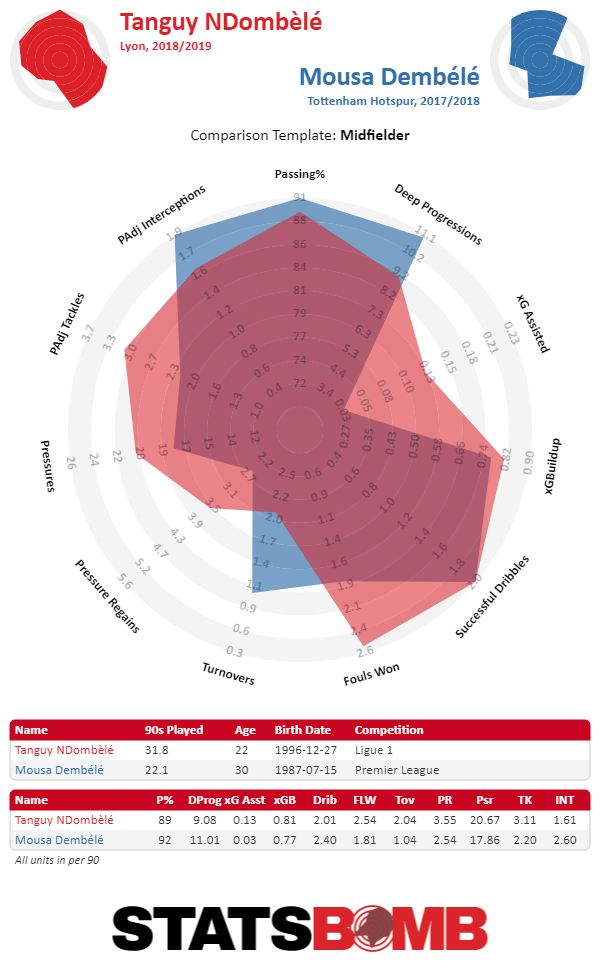 Alone, Ndombele solves almost all of the problems Tottenham had last season. His ball winning is excellent, and while not quite Mousa Dembele level, he offers much more range than Tottenham had in midfield last season. He also adds the ball progression that the team sorely lacked from midfield last season, and is perhaps the best deep midfield passer Spurs have had under Mauricio Pochettino. Mousa Dembele, who had an elite pass completion percentage rarely pinged balls across the park like Ndombele can, instead beating a man and finding a good, simple pass that way. Ndombele’s 0.13 open play expected assists per 90 minutes represents attacking incisiveness in midfield Spurs desperately needed. In Spurs’ first preseason match against Juventus, Ndombele showed Spurs fans what they have been missing, picking off a crossfield pass at the edge of the final third, taking two touches, and threading a gorgeous through ball to Lucas Moura for a goal. Rather than being overstretched as the key player in midfield, the somewhat juvenated Moussa Sissoko will be able to play a more limited role. Harry Winks and Eric Dier will now be able to play at the base of midfield for Tottenham, and perhaps Dier can return to his old self after a season of never-ending maladies: If Tottenham’s transfer window had ended with just the acquisition of Ndombele and nothing else happened, dayenu. We could have predicted that Spurs would finish with an underlying talent level of points in the high 70s, getting back to the 16-17 or 17-18 seasons, back to where they were when they had a home field advantage of any sort (notably, Spurs had no PKs awarded to them at home last season, with Wembley providing no homefield). But the offseason did not end there. With questions about Christian Eriksen’s future remaining, Tottenham went out and bought Giovani Lo Celso (at the wire), another one of the most promising young midfielders in Europe. Last season, Spurs asked Eriksen to play a deeper midfielder role, thinking that his pressure abilities and constant motor would allow him to be a free eight. It did not work. Eriksen is much more than a luxury ten, pressuring and harrying the ball while providing a great amount of creativity, but he could not translate that into the deeper role. Lo Celso, on the other hand, has proven that he can both be a true midfielder and something more attacking. In 2017-2018, Lo Celso led Ligue 1 in possession adjusted tackles per 90, and put up a stat line that was stunningly similar to Ndombele’s:
Alone, Ndombele solves almost all of the problems Tottenham had last season. His ball winning is excellent, and while not quite Mousa Dembele level, he offers much more range than Tottenham had in midfield last season. He also adds the ball progression that the team sorely lacked from midfield last season, and is perhaps the best deep midfield passer Spurs have had under Mauricio Pochettino. Mousa Dembele, who had an elite pass completion percentage rarely pinged balls across the park like Ndombele can, instead beating a man and finding a good, simple pass that way. Ndombele’s 0.13 open play expected assists per 90 minutes represents attacking incisiveness in midfield Spurs desperately needed. In Spurs’ first preseason match against Juventus, Ndombele showed Spurs fans what they have been missing, picking off a crossfield pass at the edge of the final third, taking two touches, and threading a gorgeous through ball to Lucas Moura for a goal. Rather than being overstretched as the key player in midfield, the somewhat juvenated Moussa Sissoko will be able to play a more limited role. Harry Winks and Eric Dier will now be able to play at the base of midfield for Tottenham, and perhaps Dier can return to his old self after a season of never-ending maladies: If Tottenham’s transfer window had ended with just the acquisition of Ndombele and nothing else happened, dayenu. We could have predicted that Spurs would finish with an underlying talent level of points in the high 70s, getting back to the 16-17 or 17-18 seasons, back to where they were when they had a home field advantage of any sort (notably, Spurs had no PKs awarded to them at home last season, with Wembley providing no homefield). But the offseason did not end there. With questions about Christian Eriksen’s future remaining, Tottenham went out and bought Giovani Lo Celso (at the wire), another one of the most promising young midfielders in Europe. Last season, Spurs asked Eriksen to play a deeper midfielder role, thinking that his pressure abilities and constant motor would allow him to be a free eight. It did not work. Eriksen is much more than a luxury ten, pressuring and harrying the ball while providing a great amount of creativity, but he could not translate that into the deeper role. Lo Celso, on the other hand, has proven that he can both be a true midfielder and something more attacking. In 2017-2018, Lo Celso led Ligue 1 in possession adjusted tackles per 90, and put up a stat line that was stunningly similar to Ndombele’s: 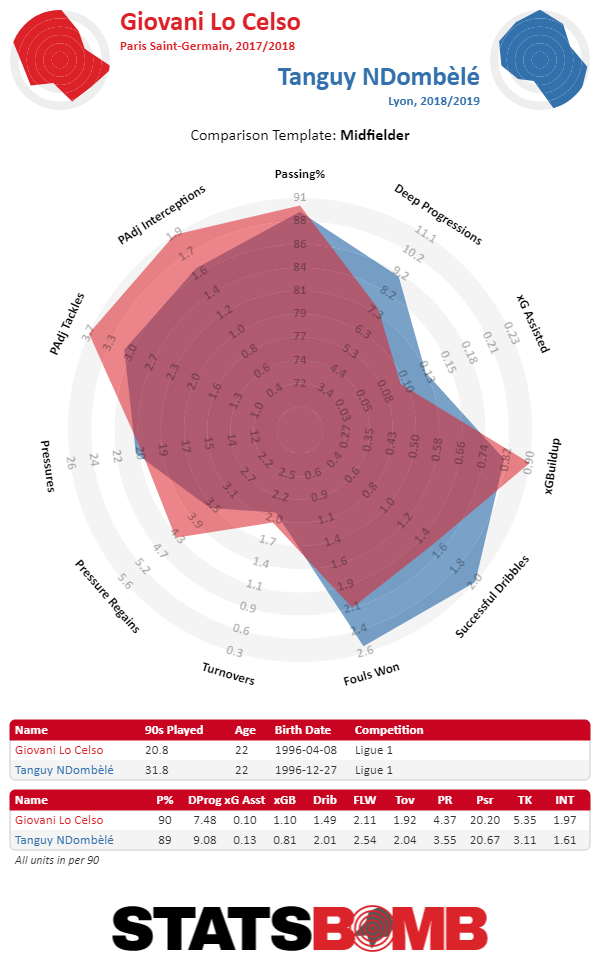 Last year, at Betis, he was asked to do more creative work and scoring, a la Eriksen, and shined brightly:
Last year, at Betis, he was asked to do more creative work and scoring, a la Eriksen, and shined brightly: 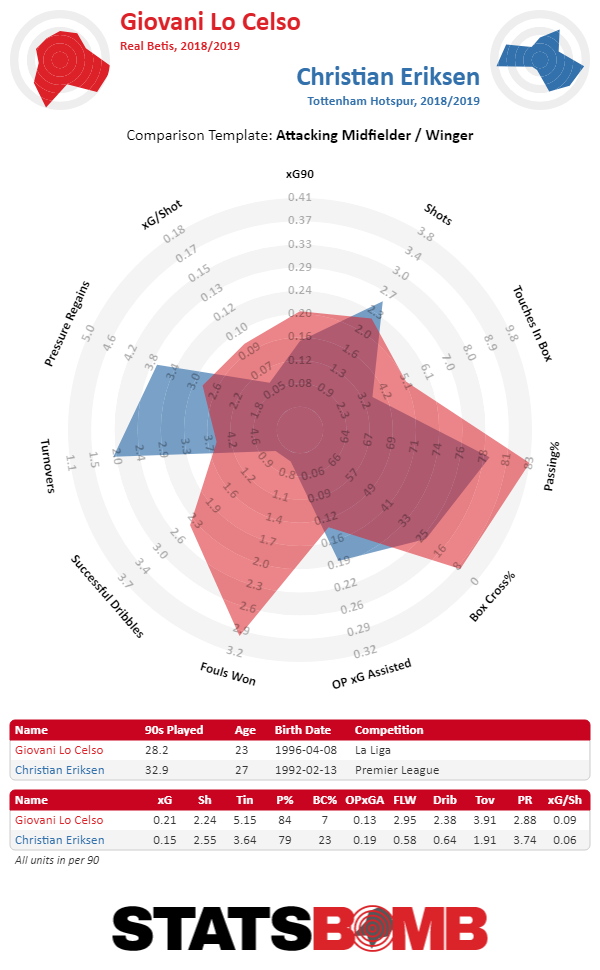 Even if Tottenham do lose Eriksen by the end of August, the additions of Lo Celso and Ndombele will have transformed the squad’s ball winning and will likely replace most of the creativity they lose if Eriksen departs. Ndombele and Lo Celso are certainly capable of playing in a pivot together given their ball winning abilities. Whether Pochettino thinks Lo Celso can play in a midfield two remains in doubt, given Spurs were looking at Bruno Fernandes, Paulo Dybala, and Philippe Coutinho in his stead. Nonetheless, in Lo Celso, Ndombele, and Dele, Tottenham now have three of the best two way midfielders in the world, providing both great ball winning and great creativity all over the pitch, albeit in vastly different ways. Far from last year’s struggles to craft a functioning midfield of any sort, this year Pochettino may be faced with difficulties getting all of his great young midfielders on the pitch. Notably, the midfield Spurs have developed is ready for a five year stretch at peak age: Winks, Lo Celso, Ndombele, and Dele are all 23 and under. The youth movement continued for Spurs at fullback. Tottenham sold Kieran Trippier and have not, as yet, replaced him. Instead, Pochettino will make due with a rotation of Serge Aurier, Kyle Walker-Peters and converted central defender Juan Foyth, though Foyth is out for at least a month now with a severe ankle injury. The decision to consider Foyth at right back has led to much consternation among Spurs fans, as Foyth’s rash defending in the box and deep belief in his technical ability has led to him making many mistakes. On the other hand, it’s hard not to see why Pochettino wants to get Foyth on the field one way or another: His list of most comparable players in the Statsbomb database offers a stunning array of talents at various positions, speaking to the Spurs fans who have wanted to see him higher up the pitch: Delaney, Lenglet, Sandro, Fernandinho, Emre Can, Jordan Amavi, Rodri, and Bouna Sarr. Putting Foyth at right back, where his dribbling and tackling skills can shine while minimizing the costs of his mistakes by taking them outside the box, may allow Tottenham to get the best from him and let him develop. While Tottenham will certainly miss Trippier’s ball progression, the additions of Ndombele and Lo Celso should mean the team will need less ball progression from its fullbacks, particularly as they should expect to win the ball higher up the pitch to begin with this season. On the other side, the club brought in Ryan Sessegnon, who was the Championship player of the year in 2017/2018 before a rockier season in the Premier League. Sessegnon is probably best suited as a wingback right now, with tons of attacking spark and solid defensive abilities, but without the pure burst to be an out and out winger or the top flight experience to defend the elite outside attackers in the Premier League. Slotted as a replacement for Danny Rose, his ability to play at left back will likely be down to Pochettino whispering his fullback magic some more. Still, a player who was at worst average as a fullback and left wing for a broken Fulham team at 18-years-old has a bright future ahead, and much of the commentary on him from last year seems to ignore just how good he was at 17 and just how bad Fulham were last season.
Even if Tottenham do lose Eriksen by the end of August, the additions of Lo Celso and Ndombele will have transformed the squad’s ball winning and will likely replace most of the creativity they lose if Eriksen departs. Ndombele and Lo Celso are certainly capable of playing in a pivot together given their ball winning abilities. Whether Pochettino thinks Lo Celso can play in a midfield two remains in doubt, given Spurs were looking at Bruno Fernandes, Paulo Dybala, and Philippe Coutinho in his stead. Nonetheless, in Lo Celso, Ndombele, and Dele, Tottenham now have three of the best two way midfielders in the world, providing both great ball winning and great creativity all over the pitch, albeit in vastly different ways. Far from last year’s struggles to craft a functioning midfield of any sort, this year Pochettino may be faced with difficulties getting all of his great young midfielders on the pitch. Notably, the midfield Spurs have developed is ready for a five year stretch at peak age: Winks, Lo Celso, Ndombele, and Dele are all 23 and under. The youth movement continued for Spurs at fullback. Tottenham sold Kieran Trippier and have not, as yet, replaced him. Instead, Pochettino will make due with a rotation of Serge Aurier, Kyle Walker-Peters and converted central defender Juan Foyth, though Foyth is out for at least a month now with a severe ankle injury. The decision to consider Foyth at right back has led to much consternation among Spurs fans, as Foyth’s rash defending in the box and deep belief in his technical ability has led to him making many mistakes. On the other hand, it’s hard not to see why Pochettino wants to get Foyth on the field one way or another: His list of most comparable players in the Statsbomb database offers a stunning array of talents at various positions, speaking to the Spurs fans who have wanted to see him higher up the pitch: Delaney, Lenglet, Sandro, Fernandinho, Emre Can, Jordan Amavi, Rodri, and Bouna Sarr. Putting Foyth at right back, where his dribbling and tackling skills can shine while minimizing the costs of his mistakes by taking them outside the box, may allow Tottenham to get the best from him and let him develop. While Tottenham will certainly miss Trippier’s ball progression, the additions of Ndombele and Lo Celso should mean the team will need less ball progression from its fullbacks, particularly as they should expect to win the ball higher up the pitch to begin with this season. On the other side, the club brought in Ryan Sessegnon, who was the Championship player of the year in 2017/2018 before a rockier season in the Premier League. Sessegnon is probably best suited as a wingback right now, with tons of attacking spark and solid defensive abilities, but without the pure burst to be an out and out winger or the top flight experience to defend the elite outside attackers in the Premier League. Slotted as a replacement for Danny Rose, his ability to play at left back will likely be down to Pochettino whispering his fullback magic some more. Still, a player who was at worst average as a fullback and left wing for a broken Fulham team at 18-years-old has a bright future ahead, and much of the commentary on him from last year seems to ignore just how good he was at 17 and just how bad Fulham were last season.
How will Spurs Play?
Last year, without a midfield, Pochettino tinkered more than ever before, playing the Air Raid and mixing and matching his players as best he could. After years of working with a 4-2-3-1 and then a 3-5-2 system, Pochettino reliably used a 4-4-2 diamond last season, pushing Dele Alli and Christian Eriksen to their limits playing both as attackers and midfielders. This season, Spurs will have much more solidity in midfield, and with it, will likely return to their suffocating pressing of years past. We should expect much more defensive activity high up the pitch, and that Pochettino will run out more midfield twos this season than last year, allowing Dele, Son, Kane, and Lucas/Eriksen/Lo Celso all on the pitch together with Ndombele and one of Dier or Winks paired with him. Perhaps we may see that Lo Celso/Ndombele pivot behind Dele, Lamela, Son, and Kane (assuming Eriksen leaves). Spurs fans should expect to see much less Moussa Sissoko, whose fit with Ndombele in a two appears quite weak. If we do see Sissoko and Ndombele together, it would likely be in a midfield three. If Lo Celso is considered a direct Eriksen replacement, expect to see Harry Winks and Eric Dier at the base of midfield quite frequently, with Sissoko the odd man out. While a legitimate European hero last season for Tottenham, a team with Spurs’ aspirations clearly needed to see fewer minutes from him, and he is now properly situated as a solid rotation option, not a locked-in starter. With Toby Alderweireld playing out his contract, and Ryan Sessegnon in tow, Spurs could also play more back 3 than they did last year, putting Davinson Sanchez on the pitch with Vertonghen and Alderweireld. We could also see back four systems with Juan Foyth at a right back/centerback flex position as the left backs push up the field more in a lopsided formation. The team also now have considerably more positional depth than it has under Pochettino, with Lucas and Erik Lamela (when healthy) legitimate attacking substitutes, who can get in behind. Eric Dier, Harry Winks, and Moussa Sissoko (along with what’s left of Victor Wanyama) as midfield rotation pieces, and Dier, Sanchez, Foyth and even Davies able to step in at center back. While at their peak Spurs could put it together - as evidenced by their Champions League run - the team simply could not compete week in and week out in the Premier League. This season, things should be different, if a little thin at fullback. After the stasis of the past two years, where does all this movement leave Spurs? While Manchester City and Liverpool look to remain world beaters, and favorite in the league, Spurs are now just a step below them. The just so stories to get Spurs to a title are easy to imagine with this squad: finishing luck or injuries do in their opponents, Harry Kane returns to his 2017/2018 form after a summer off getting shredded, or Dele, Lo Celso and/or Ndombele make another leap. On the other hand, the downsides are also apparent: Hugo Lloris reverts to merely being good after leading the league in goals saved above average (GSAA) last season. Spurs did an amazing job fixing last year’s biggest weakness, but in doing so stretched their fullback quality somewhat thin. If Foyth and Sessegnon aren’t able to perform at fullback, Tottenham could struggle down the wings. Kane could never recover. Most likely though, Spurs have separated themselves from their London rivals and Manchester United, solidifying themselves as a low 80 point talent team. The truly impressive thing about this Spurs offseason was not actually what it has done for this season, which again is likely to go to City or Liverpool. Instead, Tottenham fans should marvel at how the team is set up for the next five years to come. Spurs’ age profile is once again where Daniel Levy wants it, with 23 and under talent across the pitch, including bought and loaned back prospect Jack Clarke at Leeds. Perhaps as Liverpool and Manchester City’ peak age players need to be refreshed in the next few years, Spurs will be poised to step into that potential void. No longer symbolic of Purgatory, Spurs appear poised to ascend to the football heavens in the next half decade. Header image courtesy of the Press Association
